CHEVROLET VOLT 2012 1.G Owners Manual
Manufacturer: CHEVROLET, Model Year: 2012, Model line: VOLT, Model: CHEVROLET VOLT 2012 1.GPages: 454, PDF Size: 7.89 MB
Page 381 of 454
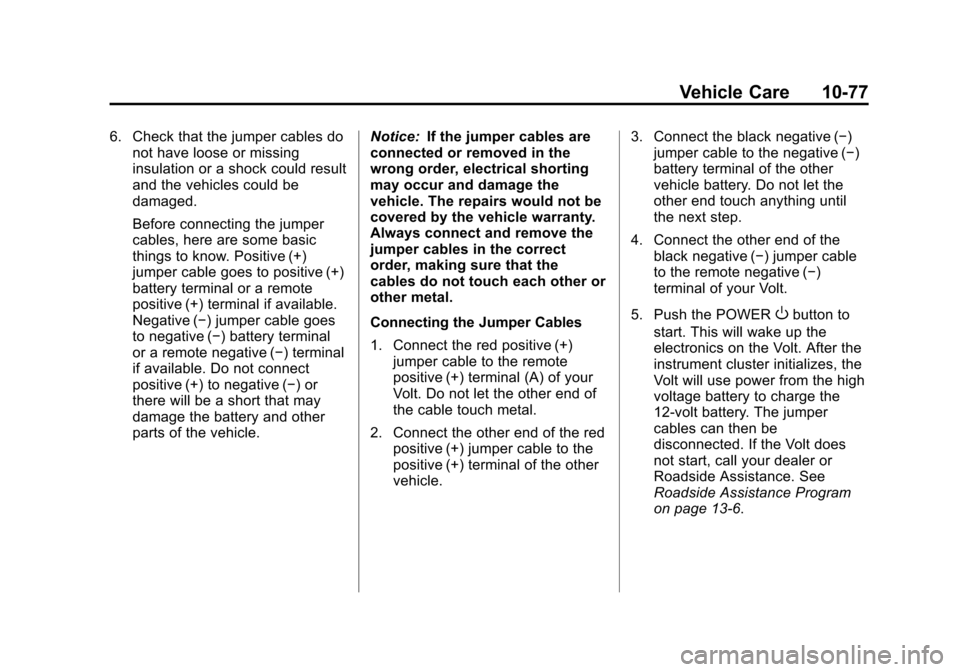
Black plate (77,1)Chevrolet Volt Owner Manual - 2012
Vehicle Care 10-77
6. Check that the jumper cables donot have loose or missing
insulation or a shock could result
and the vehicles could be
damaged.
Before connecting the jumper
cables, here are some basic
things to know. Positive (+)
jumper cable goes to positive (+)
battery terminal or a remote
positive (+) terminal if available.
Negative (−) jumper cable goes
to negative (−) battery terminal
or a remote negative (−) terminal
if available. Do not connect
positive (+) to negative (−) or
there will be a short that may
damage the battery and other
parts of the vehicle. Notice:
If the jumper cables are
connected or removed in the
wrong order, electrical shorting
may occur and damage the
vehicle. The repairs would not be
covered by the vehicle warranty.
Always connect and remove the
jumper cables in the correct
order, making sure that the
cables do not touch each other or
other metal.
Connecting the Jumper Cables
1. Connect the red positive (+) jumper cable to the remote
positive (+) terminal (A) of your
Volt. Do not let the other end of
the cable touch metal.
2. Connect the other end of the red positive (+) jumper cable to the
positive (+) terminal of the other
vehicle. 3. Connect the black negative (−)
jumper cable to the negative (−)
battery terminal of the other
vehicle battery. Do not let the
other end touch anything until
the next step.
4. Connect the other end of the black negative (−) jumper cable
to the remote negative (−)
terminal of your Volt.
5. Push the POWER
Obutton to
start. This will wake up the
electronics on the Volt. After the
instrument cluster initializes, the
Volt will use power from the high
voltage battery to charge the
12‐volt battery. The jumper
cables can then be
disconnected. If the Volt does
not start, call your dealer or
Roadside Assistance. See
Roadside Assistance Program
on page 13‑6.
Page 382 of 454
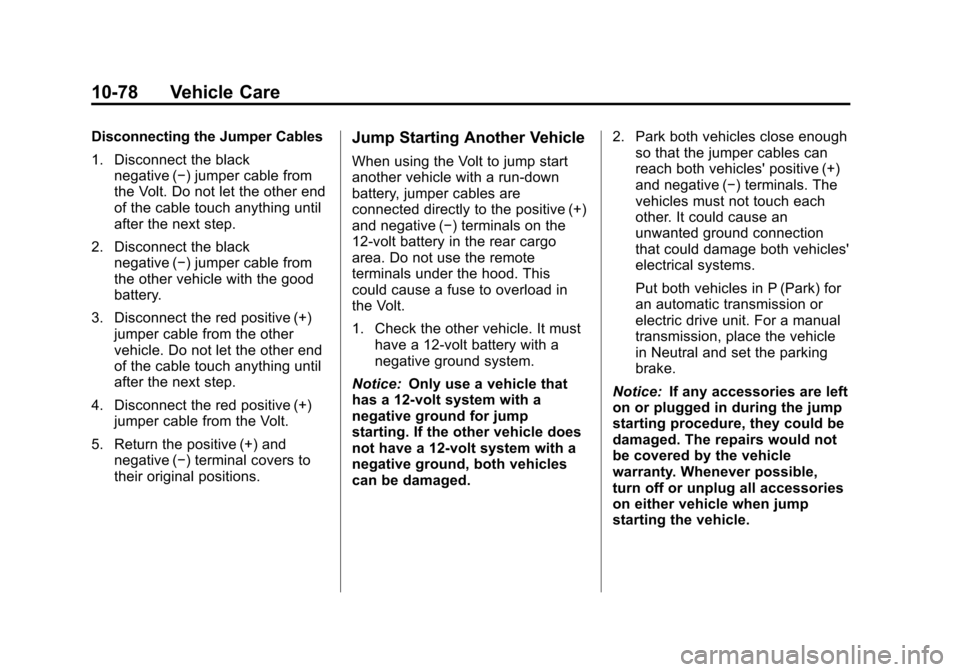
Black plate (78,1)Chevrolet Volt Owner Manual - 2012
10-78 Vehicle Care
Disconnecting the Jumper Cables
1. Disconnect the blacknegative (−) jumper cable from
the Volt. Do not let the other end
of the cable touch anything until
after the next step.
2. Disconnect the black negative (−) jumper cable from
the other vehicle with the good
battery.
3. Disconnect the red positive (+) jumper cable from the other
vehicle. Do not let the other end
of the cable touch anything until
after the next step.
4. Disconnect the red positive (+) jumper cable from the Volt.
5. Return the positive (+) and negative (−) terminal covers to
their original positions.Jump Starting Another Vehicle
When using the Volt to jump start
another vehicle with a run‐down
battery, jumper cables are
connected directly to the positive (+)
and negative (−) terminals on the
12‐volt battery in the rear cargo
area. Do not use the remote
terminals under the hood. This
could cause a fuse to overload in
the Volt.
1. Check the other vehicle. It must
have a 12‐volt battery with a
negative ground system.
Notice: Only use a vehicle that
has a 12-volt system with a
negative ground for jump
starting. If the other vehicle does
not have a 12-volt system with a
negative ground, both vehicles
can be damaged. 2. Park both vehicles close enough
so that the jumper cables can
reach both vehicles' positive (+)
and negative (−) terminals. The
vehicles must not touch each
other. It could cause an
unwanted ground connection
that could damage both vehicles'
electrical systems.
Put both vehicles in P (Park) for
an automatic transmission or
electric drive unit. For a manual
transmission, place the vehicle
in Neutral and set the parking
brake.
Notice: If any accessories are left
on or plugged in during the jump
starting procedure, they could be
damaged. The repairs would not
be covered by the vehicle
warranty. Whenever possible,
turn off or unplug all accessories
on either vehicle when jump
starting the vehicle.
Page 383 of 454
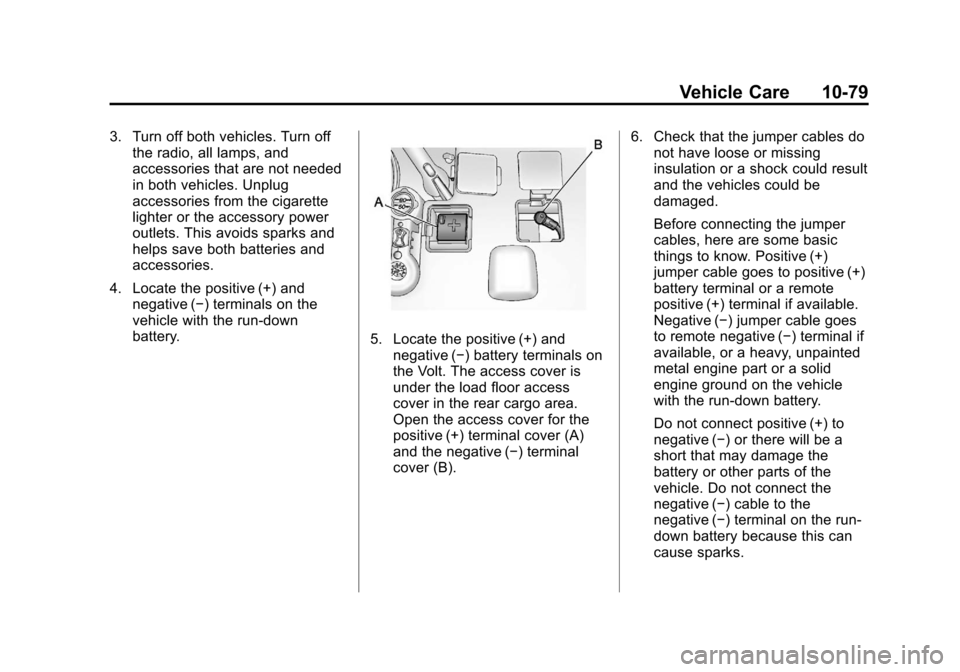
Black plate (79,1)Chevrolet Volt Owner Manual - 2012
Vehicle Care 10-79
3. Turn off both vehicles. Turn offthe radio, all lamps, and
accessories that are not needed
in both vehicles. Unplug
accessories from the cigarette
lighter or the accessory power
outlets. This avoids sparks and
helps save both batteries and
accessories.
4. Locate the positive (+) and negative (−) terminals on the
vehicle with the run‐down
battery.
5. Locate the positive (+) andnegative (−) battery terminals on
the Volt. The access cover is
under the load floor access
cover in the rear cargo area.
Open the access cover for the
positive (+) terminal cover (A)
and the negative (−) terminal
cover (B). 6. Check that the jumper cables do
not have loose or missing
insulation or a shock could result
and the vehicles could be
damaged.
Before connecting the jumper
cables, here are some basic
things to know. Positive (+)
jumper cable goes to positive (+)
battery terminal or a remote
positive (+) terminal if available.
Negative (−) jumper cable goes
to remote negative (−) terminal if
available, or a heavy, unpainted
metal engine part or a solid
engine ground on the vehicle
with the run‐down battery.
Do not connect positive (+) to
negative (−) or there will be a
short that may damage the
battery or other parts of the
vehicle. Do not connect the
negative (−) cable to the
negative (−) terminal on the run‐
down battery because this can
cause sparks.
Page 384 of 454
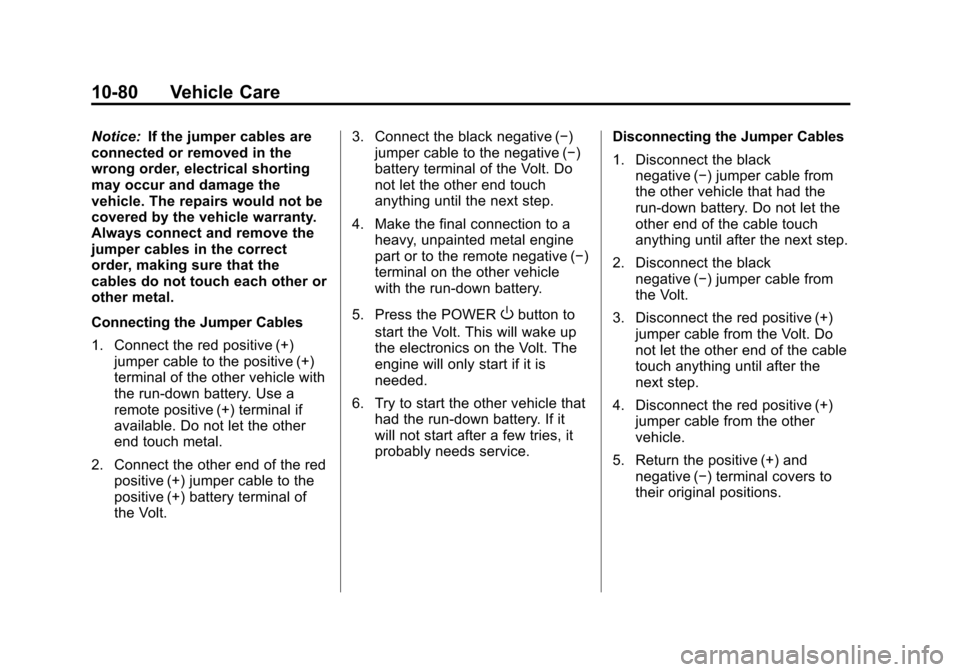
Black plate (80,1)Chevrolet Volt Owner Manual - 2012
10-80 Vehicle Care
Notice:If the jumper cables are
connected or removed in the
wrong order, electrical shorting
may occur and damage the
vehicle. The repairs would not be
covered by the vehicle warranty.
Always connect and remove the
jumper cables in the correct
order, making sure that the
cables do not touch each other or
other metal.
Connecting the Jumper Cables
1. Connect the red positive (+) jumper cable to the positive (+)
terminal of the other vehicle with
the run‐down battery. Use a
remote positive (+) terminal if
available. Do not let the other
end touch metal.
2. Connect the other end of the red positive (+) jumper cable to the
positive (+) battery terminal of
the Volt. 3. Connect the black negative (−)
jumper cable to the negative (−)
battery terminal of the Volt. Do
not let the other end touch
anything until the next step.
4. Make the final connection to a heavy, unpainted metal engine
part or to the remote negative (−)
terminal on the other vehicle
with the run‐down battery.
5. Press the POWER
Obutton to
start the Volt. This will wake up
the electronics on the Volt. The
engine will only start if it is
needed.
6. Try to start the other vehicle that had the run‐down battery. If it
will not start after a few tries, it
probably needs service. Disconnecting the Jumper Cables
1. Disconnect the black
negative (−) jumper cable from
the other vehicle that had the
run‐down battery. Do not let the
other end of the cable touch
anything until after the next step.
2. Disconnect the black negative (−) jumper cable from
the Volt.
3. Disconnect the red positive (+) jumper cable from the Volt. Do
not let the other end of the cable
touch anything until after the
next step.
4. Disconnect the red positive (+) jumper cable from the other
vehicle.
5. Return the positive (+) and negative (−) terminal covers to
their original positions.
Page 385 of 454
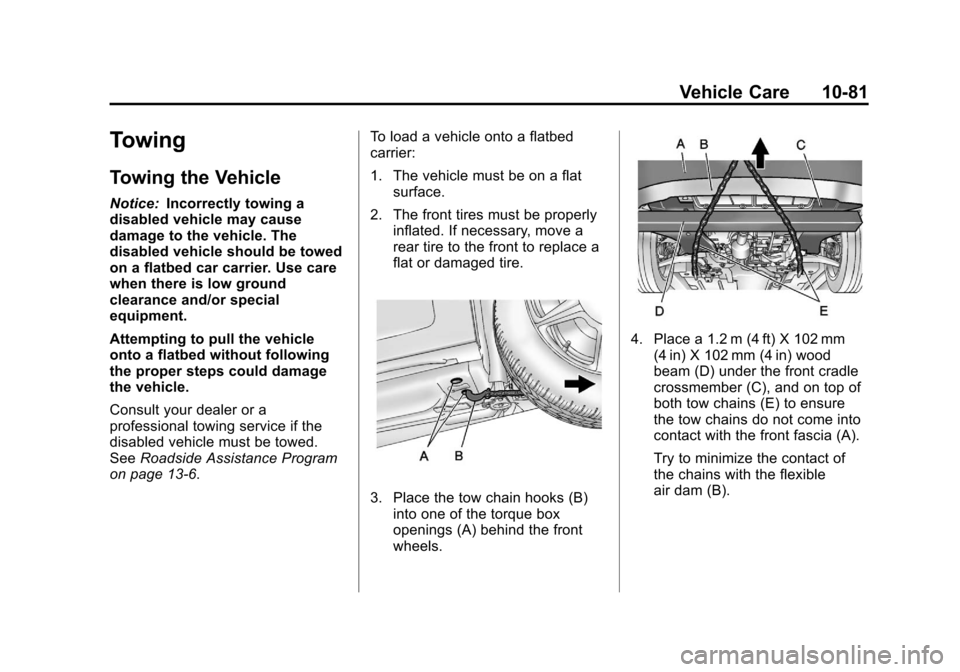
Black plate (81,1)Chevrolet Volt Owner Manual - 2012
Vehicle Care 10-81
Towing
Towing the Vehicle
Notice:Incorrectly towing a
disabled vehicle may cause
damage to the vehicle. The
disabled vehicle should be towed
on a flatbed car carrier. Use care
when there is low ground
clearance and/or special
equipment.
Attempting to pull the vehicle
onto a flatbed without following
the proper steps could damage
the vehicle.
Consult your dealer or a
professional towing service if the
disabled vehicle must be towed.
See Roadside Assistance Program
on page 13‑6. To load a vehicle onto a flatbed
carrier:
1. The vehicle must be on a flat
surface.
2. The front tires must be properly inflated. If necessary, move a
rear tire to the front to replace a
flat or damaged tire.
3. Place the tow chain hooks (B)
into one of the torque box
openings (A) behind the front
wheels.
4. Place a 1.2 m (4 ft) X 102 mm(4 in) X 102 mm (4 in) wood
beam (D) under the front cradle
crossmember (C), and on top of
both tow chains (E) to ensure
the tow chains do not come into
contact with the front fascia (A).
Try to minimize the contact of
the chains with the flexible
air dam (B).
Page 386 of 454
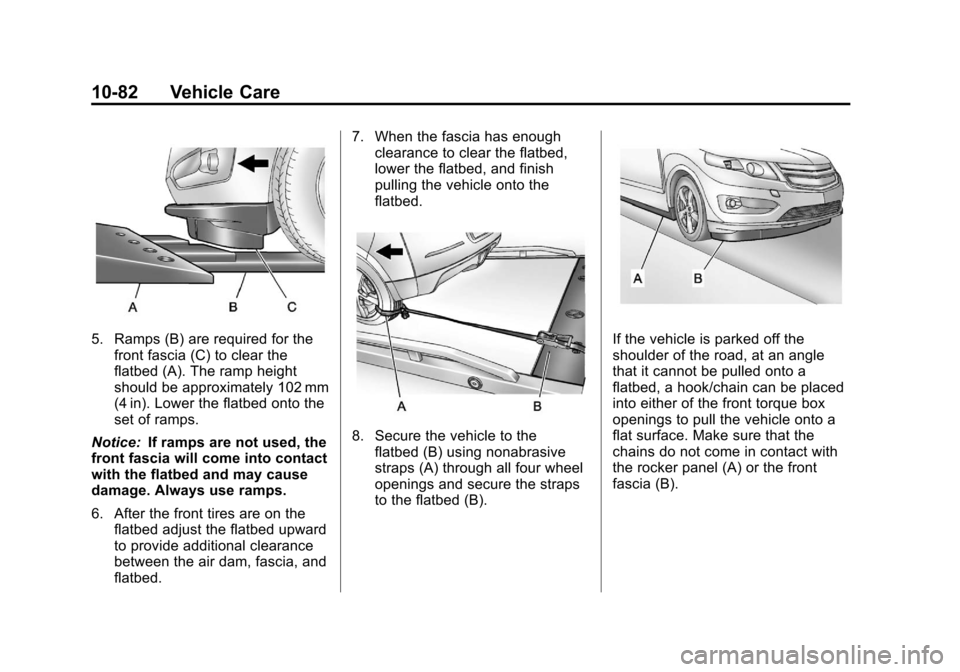
Black plate (82,1)Chevrolet Volt Owner Manual - 2012
10-82 Vehicle Care
5. Ramps (B) are required for thefront fascia (C) to clear the
flatbed (A). The ramp height
should be approximately 102 mm
(4 in). Lower the flatbed onto the
set of ramps.
Notice: If ramps are not used, the
front fascia will come into contact
with the flatbed and may cause
damage. Always use ramps.
6. After the front tires are on the flatbed adjust the flatbed upward
to provide additional clearance
between the air dam, fascia, and
flatbed. 7. When the fascia has enough
clearance to clear the flatbed,
lower the flatbed, and finish
pulling the vehicle onto the
flatbed.
8. Secure the vehicle to the
flatbed (B) using nonabrasive
straps (A) through all four wheel
openings and secure the straps
to the flatbed (B).
If the vehicle is parked off the
shoulder of the road, at an angle
that it cannot be pulled onto a
flatbed, a hook/chain can be placed
into either of the front torque box
openings to pull the vehicle onto a
flat surface. Make sure that the
chains do not come in contact with
the rocker panel (A) or the front
fascia (B).
Page 387 of 454
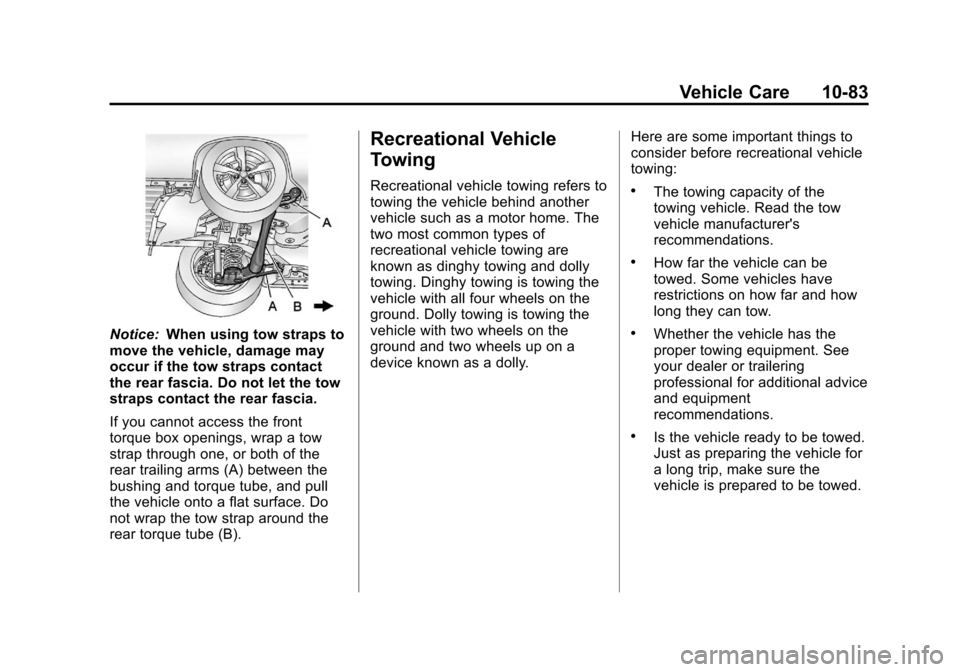
Black plate (83,1)Chevrolet Volt Owner Manual - 2012
Vehicle Care 10-83
Notice:When using tow straps to
move the vehicle, damage may
occur if the tow straps contact
the rear fascia. Do not let the tow
straps contact the rear fascia.
If you cannot access the front
torque box openings, wrap a tow
strap through one, or both of the
rear trailing arms (A) between the
bushing and torque tube, and pull
the vehicle onto a flat surface. Do
not wrap the tow strap around the
rear torque tube (B).
Recreational Vehicle
Towing
Recreational vehicle towing refers to
towing the vehicle behind another
vehicle such as a motor home. The
two most common types of
recreational vehicle towing are
known as dinghy towing and dolly
towing. Dinghy towing is towing the
vehicle with all four wheels on the
ground. Dolly towing is towing the
vehicle with two wheels on the
ground and two wheels up on a
device known as a dolly. Here are some important things to
consider before recreational vehicle
towing:.The towing capacity of the
towing vehicle. Read the tow
vehicle manufacturer's
recommendations.
.How far the vehicle can be
towed. Some vehicles have
restrictions on how far and how
long they can tow.
.Whether the vehicle has the
proper towing equipment. See
your dealer or trailering
professional for additional advice
and equipment
recommendations.
.Is the vehicle ready to be towed.
Just as preparing the vehicle for
a long trip, make sure the
vehicle is prepared to be towed.
Page 388 of 454
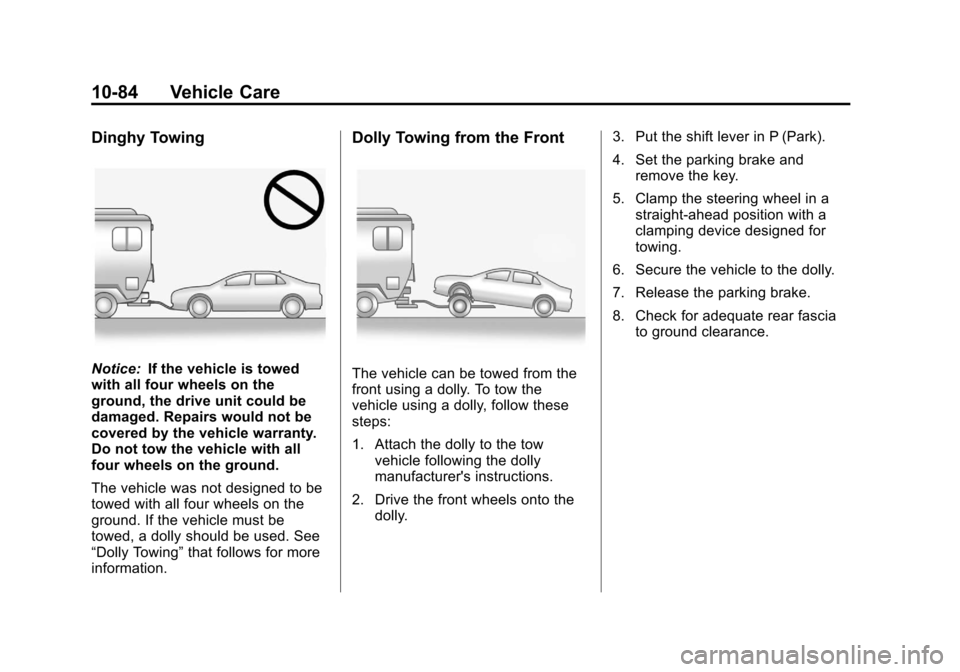
Black plate (84,1)Chevrolet Volt Owner Manual - 2012
10-84 Vehicle Care
Dinghy Towing
Notice:If the vehicle is towed
with all four wheels on the
ground, the drive unit could be
damaged. Repairs would not be
covered by the vehicle warranty.
Do not tow the vehicle with all
four wheels on the ground.
The vehicle was not designed to be
towed with all four wheels on the
ground. If the vehicle must be
towed, a dolly should be used. See
“Dolly Towing” that follows for more
information.
Dolly Towing from the Front
The vehicle can be towed from the
front using a dolly. To tow the
vehicle using a dolly, follow these
steps:
1. Attach the dolly to the tow
vehicle following the dolly
manufacturer's instructions.
2. Drive the front wheels onto the dolly. 3. Put the shift lever in P (Park).
4. Set the parking brake and
remove the key.
5. Clamp the steering wheel in a straight-ahead position with a
clamping device designed for
towing.
6. Secure the vehicle to the dolly.
7. Release the parking brake.
8. Check for adequate rear fascia to ground clearance.
Page 389 of 454
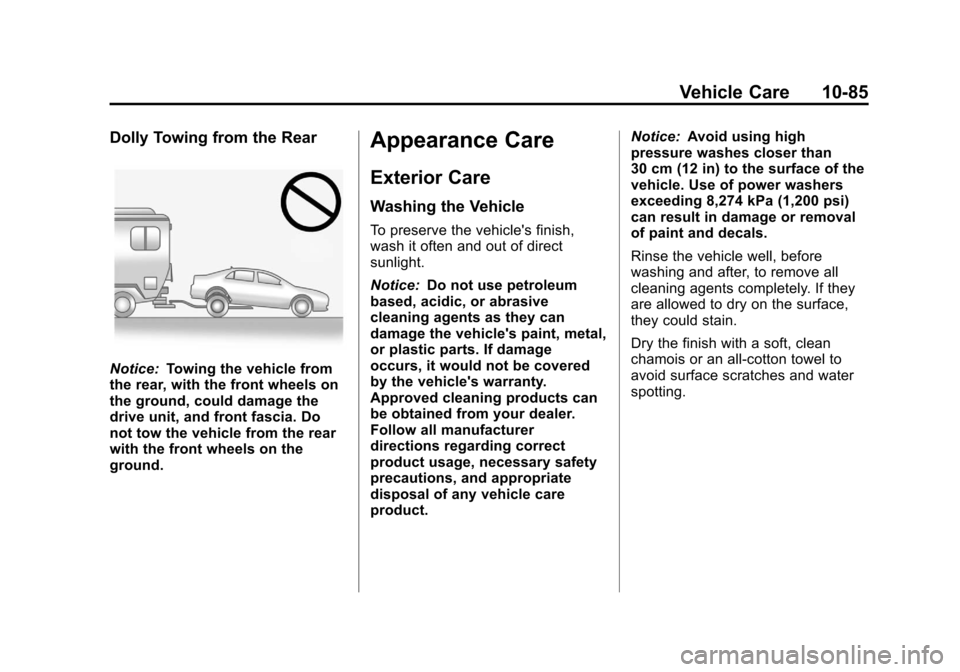
Black plate (85,1)Chevrolet Volt Owner Manual - 2012
Vehicle Care 10-85
Dolly Towing from the Rear
Notice:Towing the vehicle from
the rear, with the front wheels on
the ground, could damage the
drive unit, and front fascia. Do
not tow the vehicle from the rear
with the front wheels on the
ground.
Appearance Care
Exterior Care
Washing the Vehicle
To preserve the vehicle's finish,
wash it often and out of direct
sunlight.
Notice: Do not use petroleum
based, acidic, or abrasive
cleaning agents as they can
damage the vehicle's paint, metal,
or plastic parts. If damage
occurs, it would not be covered
by the vehicle's warranty.
Approved cleaning products can
be obtained from your dealer.
Follow all manufacturer
directions regarding correct
product usage, necessary safety
precautions, and appropriate
disposal of any vehicle care
product. Notice:
Avoid using high
pressure washes closer than
30 cm (12 in) to the surface of the
vehicle. Use of power washers
exceeding 8,274 kPa (1,200 psi)
can result in damage or removal
of paint and decals.
Rinse the vehicle well, before
washing and after, to remove all
cleaning agents completely. If they
are allowed to dry on the surface,
they could stain.
Dry the finish with a soft, clean
chamois or an all-cotton towel to
avoid surface scratches and water
spotting.
Page 390 of 454
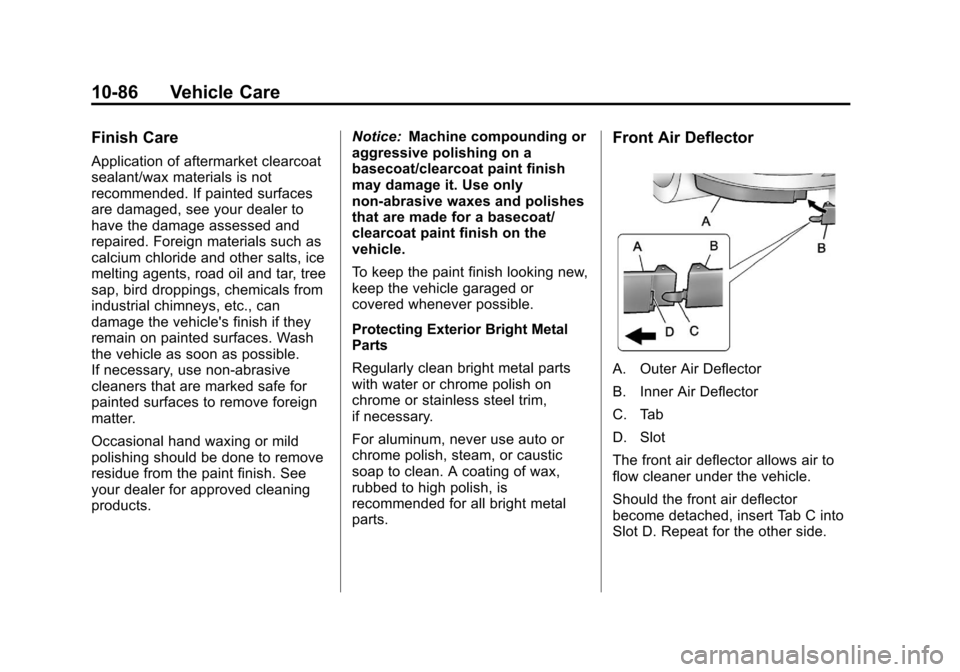
Black plate (86,1)Chevrolet Volt Owner Manual - 2012
10-86 Vehicle Care
Finish Care
Application of aftermarket clearcoat
sealant/wax materials is not
recommended. If painted surfaces
are damaged, see your dealer to
have the damage assessed and
repaired. Foreign materials such as
calcium chloride and other salts, ice
melting agents, road oil and tar, tree
sap, bird droppings, chemicals from
industrial chimneys, etc., can
damage the vehicle's finish if they
remain on painted surfaces. Wash
the vehicle as soon as possible.
If necessary, use non-abrasive
cleaners that are marked safe for
painted surfaces to remove foreign
matter.
Occasional hand waxing or mild
polishing should be done to remove
residue from the paint finish. See
your dealer for approved cleaning
products.Notice:
Machine compounding or
aggressive polishing on a
basecoat/clearcoat paint finish
may damage it. Use only
non-abrasive waxes and polishes
that are made for a basecoat/
clearcoat paint finish on the
vehicle.
To keep the paint finish looking new,
keep the vehicle garaged or
covered whenever possible.
Protecting Exterior Bright Metal
Parts
Regularly clean bright metal parts
with water or chrome polish on
chrome or stainless steel trim,
if necessary.
For aluminum, never use auto or
chrome polish, steam, or caustic
soap to clean. A coating of wax,
rubbed to high polish, is
recommended for all bright metal
parts.
Front Air Deflector
A. Outer Air Deflector
B. Inner Air Deflector
C. Tab
D. Slot
The front air deflector allows air to
flow cleaner under the vehicle.
Should the front air deflector
become detached, insert Tab C into
Slot D. Repeat for the other side.